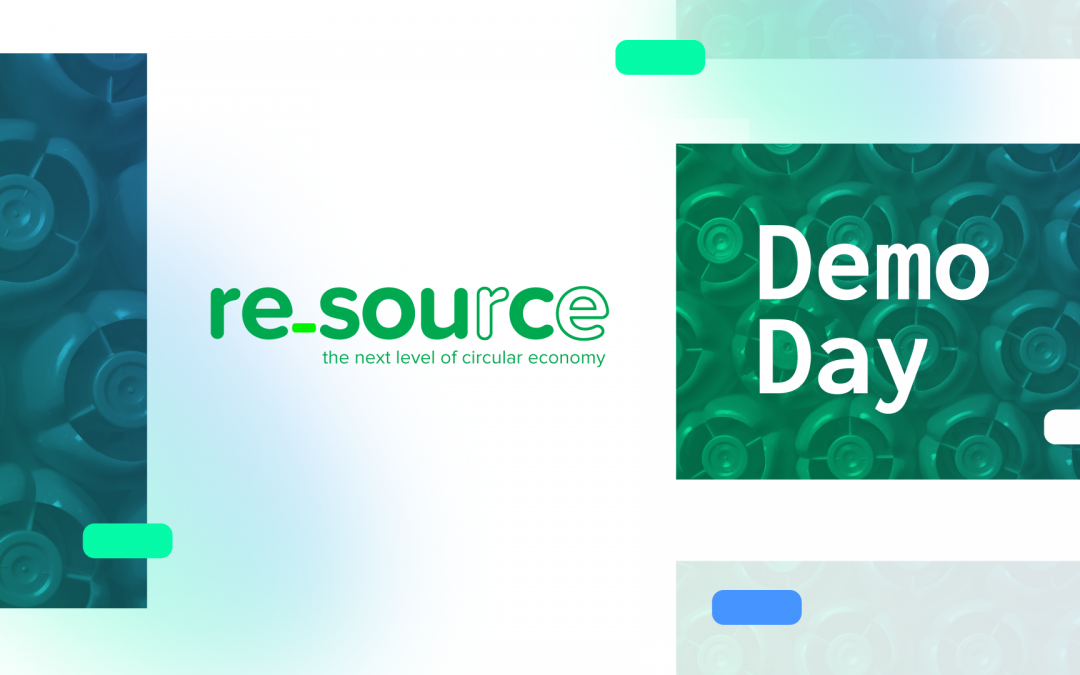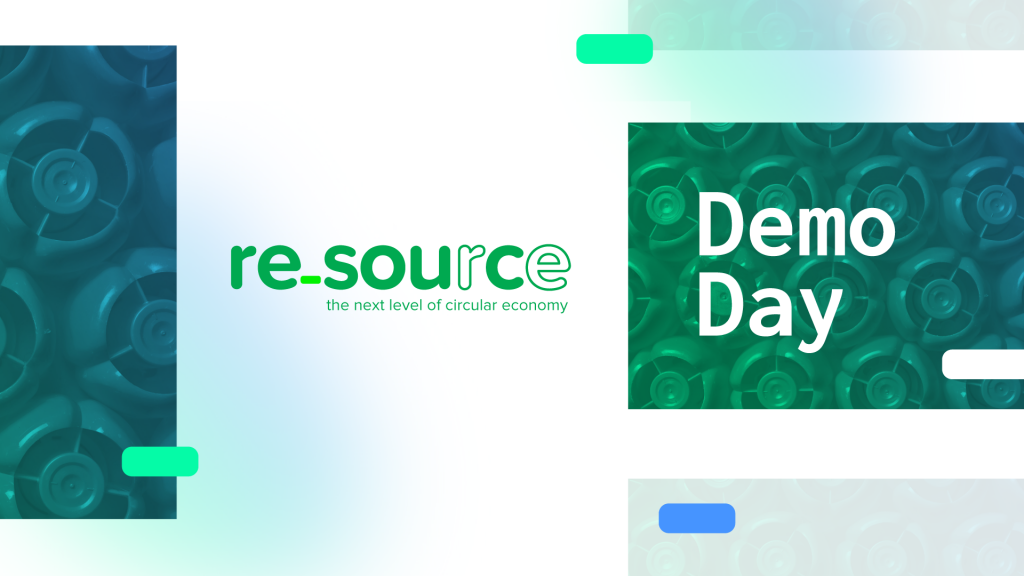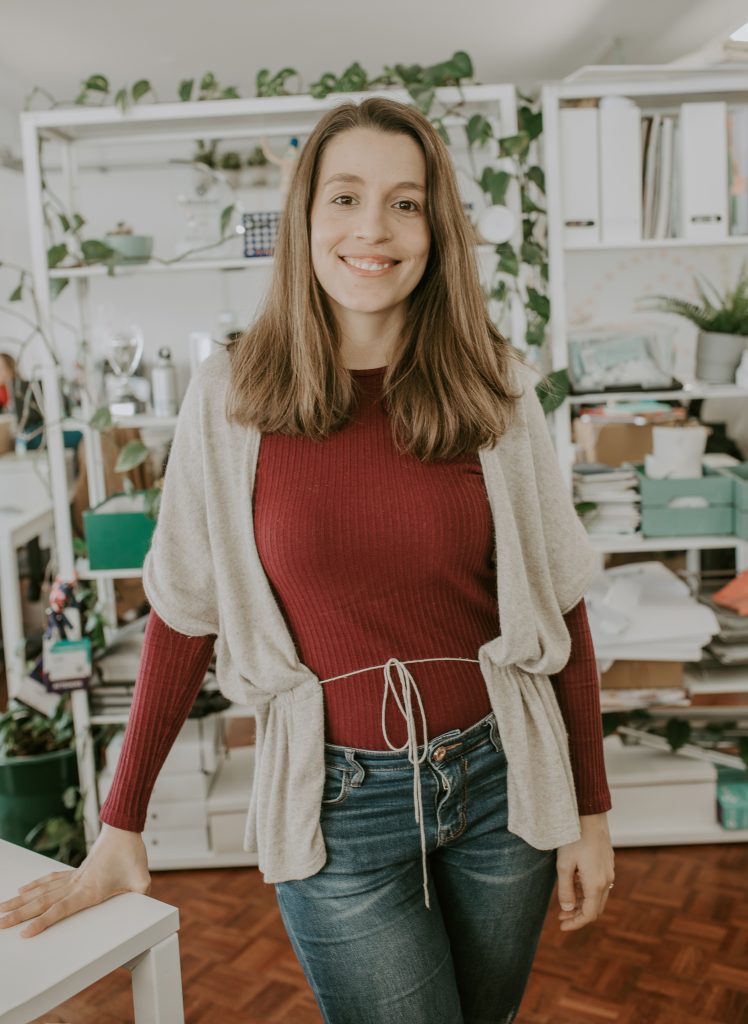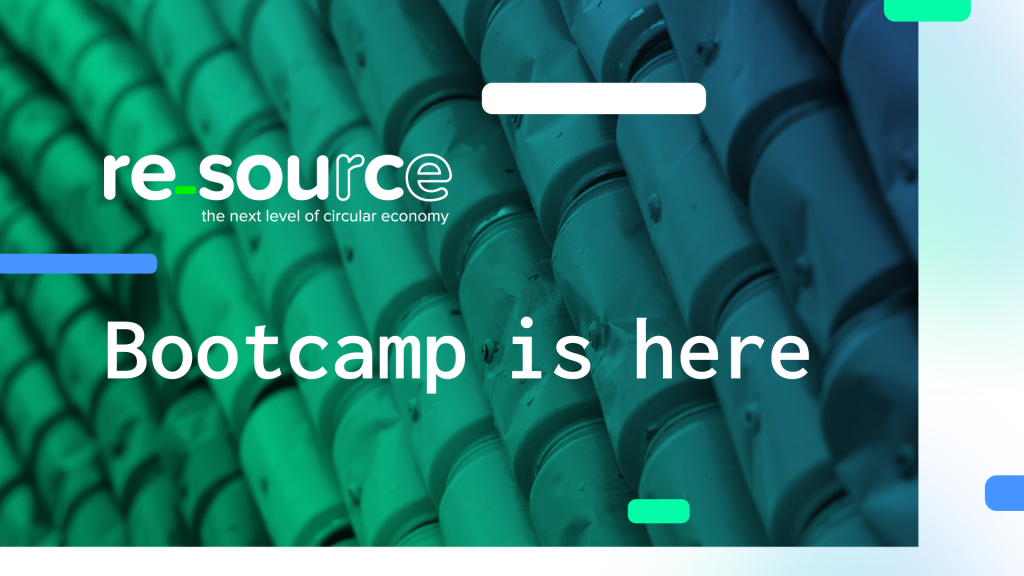
by cristina | Dec 14, 2021 | Corporates, Startups
“This partnership with Beta-i brought us extraordinary results, because we got to the end with solutions that actually solve critical and real problems and are aligned with Sociedade Ponto Verde’s strategic goals.”
Ana Trigo Morais, CEO at Sociedade Ponto Verde.

The Demo Day of re_source program marked the end of this pioneer edition in taking the next level of circular economy. It was also the time to show the collaborative work made between the startups and the pilot partners, throughout the last months:
FYCH & Nestlé | Tratolixo | Sociedade Ponto Verde
Startup FYCH, from Spain, is fighting the lack of structure to recycle multilayer packaging and the negative impacts that this gap has for brands. The innovators at FYCH are doing it together with Nestlé, Tratolixo and Sociedade Ponto Verde, by implementing – in recyclers of the Integrated System of Packaging Waste Management (SIGRE) – their delamination technology to separate the various layers of materials of these packages and enhance their recycling.
FYCH & Lusoforma
This time partnering with Lusoforma, the startup has also tested its technology in the recycling of the lid of aluminum take-away products, which are composed of paper, plastic and aluminum, obtaining separation results of 100%.
Magnomer & Super Bock Group | Tratolixo
Magnomer is creating a pilot with the Super Bock Group. The project consists of creating labels with magnetized ink, meaning they can be more easily separated from the plastic, hence allowing for better packaging recycling. The solution from the North American startup can increase recycling levels by up to 20% and make Super Bock the first company in Portugal to apply 100% recyclable labels on its bottles. Tratolixo will also be a partner in the screening tests of these packages.
Reath & Sociedade Ponto Verde | Super Bock Group
Coming all the way from Scotland, Reath has teamed up with Sociedade Ponto Verde and the Super Bock Group to monitor the packaging life cycle – through the creation of a digital passport to be placed on physical products. Overall, this solution will provide companies and consumers with the proper data on the usability and life cycle of a package and on which products are placed inside. Specifically to Sociedade Ponto Verde, it will allow the company to obtain information on non-reusable packaging placed on the market, as well as the necessary information to fill out the annual declaration (document that companies adhering to the Green Dot system fill out annually to report the total weight of this packaging).
Polytag & Lipor | Tratolixo | Sociedade Ponto Verde
Polytag, from the UK, has teamed up with Lipor, Tratolixo and Sociedade Ponto Verde to create a digital deposit return and rewards scheme in the Porto area. Their solution will use Polytag’s “describe, tag and trace” technology to first tag products with unique identifiers. Then, it will allow consumers to scan the codes with a purpose-built application and claim their deposits in the comfort of their homes. All this, without having to use inconvenient and expensive vending machines. The packaging will be disposed of via their normal bin or communal container system, creating a cheaper, more convenient and effective deposit return scheme in the area.
MyResonance & Lusoforma | Lipor
Also from the UK, innovators at MyResonance are working together with Lusoforma and Lipor to implement a social network in Portugal. It should use gamification techniques to empower organizations to communicate, promote and engage their communities to take collective action around ESG-based initiatives. This would turn each person/user into a brand ambassador while positively building an online presence and identity to promote a cleaner world.
More about re_source:
Re_source 2021 Video | Re_source: the brave ones taking the next level of circular economy | It’s time for re_source Bootcamp

by cristina | Dec 7, 2021 | Corporates, Startups
by Gonçalo Faria* | originally published in Jornal Económico
In the last weeks, no topic has been as talked about as COP26, and there is no shortage of opinion leaders with opposing views on the results and the final agreement. In reality, we are all beginning to realize the scale of the transformation that we will have to face in the coming years and the need to rapidly accelerate a decarbonization that is only taking too long to become a reality. And the fact is that, with or without a COP, with more or less regulation, the business sector in general knows the direction of the actions it should take.

At the same time we are going through a phase in which supply chains are suffering one of the most disruptive periods of our generation, with threats of shortages of essential raw materials, long queues of ships waiting to unload containers, maritime freight prices at unimaginable highs and consequent price increases of raw materials and consumer products.
But what does decarbonization have to do with crises in supply chains? We could talk about the need to curb emissions in shipping and the profound change that this sector will face in the coming years with the reduction targets imposed by the European Commission, and the experiments of introducing green fuels such as hydrogen or ammonia. But there is another important decarbonization lever which will be the paradigm shift of our value and supply chains towards a circular future, with much shorter logistics and a huge reduction in the carbon footprint of the materials we consume.
If we consider only the primary production of metals, currently it represents around 7 to 8% of the global energy consumption. By moving to a secondary use, to a circular chain of reuse or recycling, energy consumption is reduced by a factor of 10. If metals are an extreme example, the need to redesign value chains and the way we consume and derive utility from materials/products, or how companies design this consumption experience, will be fundamental to achieve the much desired carbon neutrality. According to the Circularity Gap Report 2021, doubling the circularity of the global economy from 8.6% to 17% reuse of materials can reduce greenhouse gas emissions by 39%.
This circular transformation is creating very exciting economic opportunities for entrepreneurs and large companies and could have significant potential for increased employment. Entrepreneurs are already playing their part and the challenges of this deep circular transformation are the opportunities they are seizing. This is currently a very dynamic ecosystem, and examples are surely not lacking. Such as Waste Transformers who developed a containerized solution for the anaerobic digestion of organic waste for energy production and organic fertilizer, or Reath who developed a digital passport for materials to enable their Traceability.
We will need to give space to these innovative solutions, new business models and new technologies, and we will only achieve this in a collaborative way and by opening a path of dialogue and experimentation between the various stakeholders such as entrepreneurs, large companies, consumers, regulators and local entities such as municipalities or multilateral ones such as the United Nations and the COP26.
*Gonçalo Faria is Senior Account Manager – Client Success at Beta-i.

by cristina | Nov 23, 2021 | Featured
by Maria Raimundo* | originally published in Observador
The transformation of digital health has highlighted the need for the entire industry and medical practice entities to operate and keep patients at the center. Patient centralization has influenced national guidelines and policies in several countries and organizations, including the US, UK, EU, and the World Health Organization (WHO). The concept of patient-centered care adopts a conscious perspective of the patient. As an example, the importance of the patient’s interactions with service providers and institutions. When the patient interacts with the healthcare system, he/she interacts with various stakeholders throughout the process. However, healthcare has taken unexpected directions, including placing patient-centeredness in larger circumstances that are transforming 21st-century medicine.

The healthcare system is part of an ecosystem, a larger concept where several patient-centered entities act. Players, such as Big Tech companies or innovators of Digital Health solutions, were not previously included in the traditional healthcare system. Besides patients interacting with the healthcare system, system stakeholders also interact with each other to maintain well-being and patient-centered care. This new collaborative health paradigm is building a new multipolar ecosystem. It includes hospitals and other primary care centers, medical industry companies, universities, patient associations, startups and SMEs, foundations and NGOs, among other governmental and regional institutions. Here, collaboration is joining capacities, interests, and knowledge between all these entities present in the ecosystem, to create innovative initiatives for change, and go far beyond the doctor-patient relationship.
Within this new ecosystem, everyone shares information, engagement, and responsibility. Consequently, both knowledge and technology are converging and crossing boundaries between entities. Therefore, there is a need for all stakeholders to join together and form consortia to explore possible synergies. The goal is to 1) cooperate in delivering services, professional training plans, innovation, and research; and 2) reflect on how health is organized and oriented towards innovation. These goals are not only common to the healthcare system, but also to the digital health strategy to be adopted. Entities need to discuss and define healthcare innovation requirements, interest in participating in pilot projects and help with its implementation efforts. Collaboration is key for entities to implement innovative, sustainable and effective initiatives beyond pilot projects. Only then will healthcare transformation needs be met, of today and for the future. It is, therefore, necessary to consider the value that each entity brings, propose improvements according to each one’s needs, and ultimately face the solution as an ecosystem.
We need a digital healthcare transformation that respects the entities involved, that is bold enough to collaboratively assess what is needed, what didn’t work, what is an exaggeration, and what brings value. Where entities align the change needed to improve the quality, availability, and value of care. What needs to stop? What is worth replacing or needs to happen in the vast landscape of digital healthcare evolution? Hospitals or government institutions are just two parts of this ecosystem. The key to the success of a sustainable future healthcare transformation is also in the remaining stakeholders. Where can companies, associations, startups and SMEs, foundations, among others, provide value, suggest improvements and contribute to the development and implementation of new solutions?! The solution is collaborative!
* Maria Raimundo, 31 years old, is a Biomedical Engineer with a master’s degree in Entrepreneurship and Innovation Management within Life Sciences. She currently works at Beta-i, a collaborative innovation consultancy, as Senior Account Manager, promoting Digital Health innovation throughout the healthcare ecosystem. While attending the PhD program at MIT Portugal, Maria focused on the challenges of using and sharing genetic data. Her interests in eHealth, personalized medicine, genetics, nutrition and innovation led her to the United Nations, MIT, as well as professional experience in startups.

by cristina | Oct 6, 2021 | Uncategorized
This is an article by Mariana Santos Silva, Head of Talent at Beta-i. It was originally published in the digital newspaper Eco.

Most of our struggles in different relationships come from a place of bad or incomplete communication: parents and their children with completely different mindsets and perspectives often don’t know how to speak each other’s languages; couples often assume the other person has the psychic ability to guess what the other is thinking and wishing for, thus resulting in a huge gap of communication. This is no different in the workplace – a lot of the frictions we find at work with colleagues or managers could be solved if we communicated honestly, respectfully, and promptly.
This is one of the reasons why feedback and having a culture based on constructive communication is something so fundamental in an organization. At Beta-i, for example, Feedgize is one of our superpowers – Feedgize is the merge of two words: Feedback + Energize, and stands for “Energizing yourself through constant feedback.” These analyses are a powerful communication tool to have a deeper understanding of collaborators, themselves, and their colleagues, providing the insights and the necessary energy to improve.
It’s inspiring to think of constant evaluation, but it takes time and intentionality to build one. It’s about showing why feedback is important for a healthy culture, creating moments for it to happen, learning how to give and receive it, as well as the concrete steps needed to progress.
Here are some examples of constructive communication in action:
Building understanding is the main component. Imagine when two companies merge, in addition to combining knowledge, this transition also creates a lot of challenges, such as different cultures, different ways of working, insecurities, and questions. One can think that a top-down approach is a way to handle it, with strict guidelines on how to work and how to behave, but I think trusting people to become a team and getting there together is a better way. This is what happened in Beta-i back in 2018 when we merged with Couture and had 60 – new – people discovering how to work together as a team. One of our initiatives was to implement a feedback challenge – not necessarily a manager-direct report, but a peer-to-peer one. This was when we partnered with Skoach, the micro-learning virtual coach, to create safe spaces for these conversations to happen, making our team feel safer and more open to listening and receiving productive reports to progress and build on those assessments.
It’s fair to think that giving feedback is a skill that needs coaching to achieve. However, for the person receiving and listening is just as important and as difficult, and there’s much to be learned about the act of listening (check this TED Talk from Celeste Headlee on how to have better conversations). “Seek to listen first” was one of the ancient values of Beta-i, inspired by Buffer’s value “Listen first, then listen more,” and that was what we decided to do at Beta-i after restructuring, a process that is often difficult with loose ends and a lot of doubts. Simply asking “what are your concerns about this situation?” and “what ideas do you have to improve it?” can be much more powerful than leadership or management trying alone to come up with solutions or wear out pitching why this is a better way.
I’m a true believer that performance management systems should look to the future and not focus only on the past. Ultimately, we want these assessments to be able to improve things and not only to evaluate. “Feedgize sessions” is the name that Beta-i gave to bi-annual feedback sessions focused on growth and development and based on a 360 perspective (self, peers, direct reports, and manager). To complement these conversations that take place every six months, there are also monthly “coffee awareness chats” between managers and direct reports. The result is an ongoing conversation about growth and development opportunities that allow employees to understand how they are performing and how to constantly advance and move forward in their careers.
When seeing feedback in action it is easy to understand why it is an essential communication tool that should be embedded into organizations. First, intentionally, and then, organically. These assessments allow for teamwork to happen and make us get out of our bubble to understand one another and collaborate. Feedback feeds collaboration, which then boosts innovation and progress, and that’s what organizations should be all about.
Mariana Santos Silva | Head of Talent at Beta-i

by cristina | Jul 1, 2021 | Featured
The digital open innovation program by Sociedade Ponto Verde to innovate packaging waste has already kicked-off. Re_source’s bootcamp is happening on June 28, 29 and 30 and on July 7, 8 and 9.
This journey of innovation will be fully digital, where the selected startups and innovators will meet the brave pilot partners of this special program.
The bootcamp includes sessions especially designed for partners and startups, pitches, preparation of one-on-one meetings, as well as deep dive conversations between both parties to define scope and purpose of their collaborations.
The participating startups will be split by challenge, so that each program’s category is covered with innovative solutions. In the end, both startups and pilot partners will have found their “match” and define further steps to their solutions for packaging waste.

Among so many well qualified applications, it was not easy to decide who should move to this phase of the program, but re_source has selected 19 top startups to participate in the bootcamp:
Arqlite is developing highly efficient materials for massive industries, made 100% from discarded plastics.
An AI-based smart waste bin, designed for public places, enabling them to achieve efficiency in waste management and reach green strategy goals.
Technology for hotels, restaurants, and apartment buildings to ensure recyclables are sorted by customers before disposal, and the internal collection process of recyclables is streamlined.
Digitization, cloud data and blockchain technology to store and facilitate seamless sharing of information about plastic waste and map waste flows.
Delamination technology, used to recycle complex/multilayer plastic packaging by separating each of the materials that comprise the packaging and recovering all of them.
GreenPlat is a SaaS in blockchain that covers the whole production, managing environmental indicators and the supply chain and destination of companies.
Magnetic ink-based technology for recyclable packaging. he inks allow recyclers to magnetically (and economically) sort packaging elements during recycling.
Mudatuga believes in the power of education and community, spreading the compost awareness with a sense of humor and proximity to the public.
A social network that empowers forward-thinking organizations to communicate, promote and engage their communities to take collective steps around ESG-based initiatives.
Waste-based sustainable blocks for wood pallets and packaging. These blocks are made 100% from upcycled resources dumped everyday on landfills.
A patent-pending Tag and Trace technology that allows packaging manufacturers and brands to assign unique individual codes to each unit of a product.
A smart bin able to automatically differentiate waste thanks to machine learning and image recognition techniques.
Reath ((track & trace + analytics and BI tools) enables businesses to adopt and grow scalable circular packaging systems fit for the 21st century.
The only solution able to identify unmistakably all types of packaging waste with one device.
Personalized white-labeled service of recycling information and rewards for retailers and brand owners.
Peer-to-peer marketplace where users can hitch a ride for things they need recycled or moved.
Trash4Goods is a gamification platform that rewards users for recycling.
The world’s first patent bio-based material made entirely of unsorted household waste.
A tech company that helps collect more trash to recycle with software of AI, APPS and traditional IT systems combined together with its developed HW(machine).










